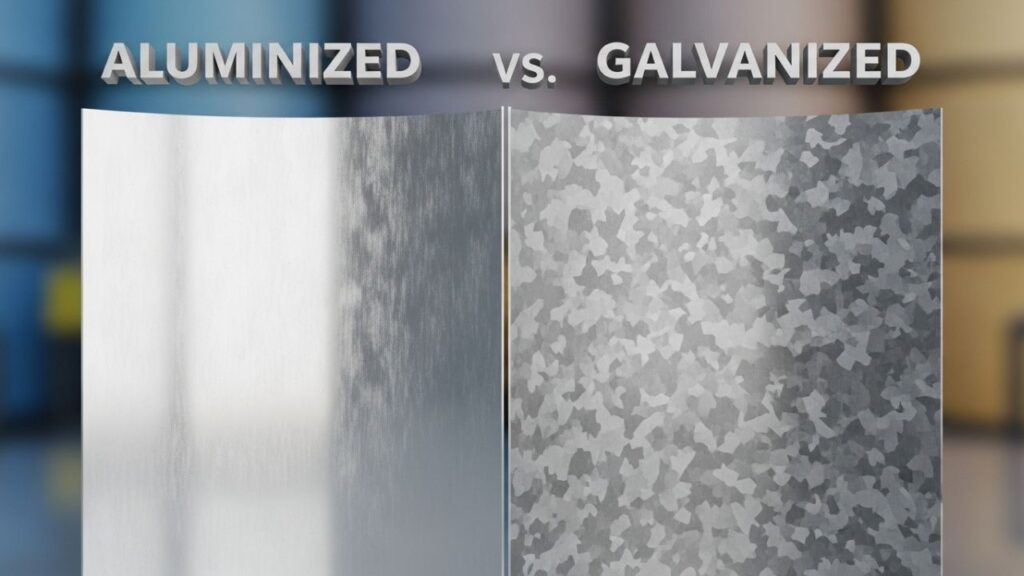Introduction: Aluminized vs Galvanized – What’s the Difference?
When it comes to choosing the right type of steel for your project, the comparison of aluminized vs galvanized steel often comes up. Both are popular due to their protective coatings and corrosion-resistant properties. However, understanding the differences between aluminized and galvanized coatings is critical if you want long-lasting, cost-effective, and high-performance results.
In this article, we’ll dive deep into what makes aluminized and galvanized steel different, where each excels, and how to decide which is best suited for your needs.
What Is Aluminized Steel?
Aluminized steel is regular carbon steel that has been coated with an aluminum-silicon alloy. The process involves hot-dipping the steel into a bath of molten aluminum, which forms a tight bond with the surface.
Key Features of Aluminized Steel:
-
Heat Resistance: Excellent for high-temperature environments
-
Corrosion Resistance: Performs well in both wet and dry conditions
-
Reflectivity: Highly reflective, making it energy efficient
-
Durability: The aluminum layer prevents rust and oxidation
Applications of Aluminized Steel:
-
Automotive mufflers and exhaust systems
-
Heat shields and ovens
-
Chimneys and flues
-
HVAC components
Because of its ability to withstand high temperatures, aluminized steel is ideal for applications involving heat exposure.
What Is Galvanized Steel?
Galvanized steel is carbon steel that has been coated with a layer of zinc to protect against corrosion. The most common method is hot-dip galvanizing, where steel is submerged in molten zinc.
Key Features of Galvanized Steel:
-
Rust Protection: Zinc coating acts as a barrier and sacrificial layer
-
Affordability: Generally more cost-effective than aluminized steel
-
Easy to Weld and Paint: Compatible with many fabrication processes
-
Availability: Widely used and easy to source
Applications of Galvanized Steel:
-
Outdoor construction (roofs, fences, handrails)
-
Agricultural and marine equipment
-
Electrical poles and utility boxes
-
Automotive body parts
For general outdoor use and low-heat applications, galvanized steel is often the go-to option.
Aluminized vs Galvanized: Head-to-Head Comparison
Let’s explore how aluminized vs galvanized steel stack up across key factors:
1. Corrosion Resistance
-
Aluminized Steel: Offers better corrosion resistance in high-temperature environments and acidic conditions.
-
Galvanized Steel: Excellent in atmospheric conditions, especially where water and humidity are present.
Winner: Aluminized steel for heat and chemicals, galvanized for outdoor exposure.
2. Heat Resistance
-
Aluminized Steel: Performs up to 1200°F (650°C) without degrading.
-
Galvanized Steel: Zinc melts at around 787°F (420°C), limiting its use in high-heat areas.
Winner: Aluminized steel excels in high-temperature settings.
3. Cost Efficiency
-
Aluminized Steel: Generally more expensive due to its complex manufacturing and specialized uses.
-
Galvanized Steel: More affordable and widely available.
Winner: Galvanized steel is more cost-effective.
4. Aesthetic & Finish
-
Aluminized Steel: Shiny, smooth finish; excellent reflectivity.
-
Galvanized Steel: Dull gray finish with spangle patterns.
Winner: Depends on the aesthetic requirement, though aluminized looks more polished.
5. Lifespan and Durability
-
Aluminized Steel: Can last 15–20 years, especially in heat-intensive environments.
-
Galvanized Steel: Can last 20–50 years, depending on the climate and exposure.
Winner: Galvanized steel typically lasts longer in regular outdoor conditions.
Aluminized vs Galvanized: Pros and Cons
Aluminized Steel Pros:
-
High heat resistance
-
Great for chemical environments
-
Smooth and reflective finish
Aluminized Steel Cons:
-
More expensive
-
Limited availability in some markets
Galvanized Steel Pros:
-
Inexpensive and easy to source
-
Excellent general corrosion resistance
-
Long-lasting in outdoor environments
Galvanized Steel Cons:
-
Poor performance at high temperatures
-
Can suffer from white rust in humid storage
Which One Should You Use?
Choosing between aluminized vs galvanized steel depends on the specific requirements of your project.
Use Aluminized Steel If:
-
You need heat-resistant materials (e.g., auto parts, ovens)
-
You’re working in a chemically aggressive environment
-
Appearance and surface finish matter
Use Galvanized Steel If:
-
You’re doing outdoor construction or fencing
-
Cost is a major concern
-
You need general corrosion resistance without high heat
Industry Insights and Future Trends
As the demand for environmentally friendly and longer-lasting materials grows, advancements in coating technologies may further improve both aluminized and galvanized steel. Smart coatings, hybrid materials, and improved galvanization methods are already under research.
Sustainable practices, like recycling and lower-emission manufacturing, are also influencing choices in the aluminized vs galvanized debate. Both materials are recyclable, making them eco-conscious choices for modern engineering and architecture.
Conclusion: The Final Verdict on Aluminized vs Galvanized Steel
In the debate between aluminized vs galvanized steel, there’s no one-size-fits-all answer. Each type has its own advantages depending on your budget, use case, and environmental conditions.
-
Choose aluminized for high-heat and specialty applications.
-
Choose galvanized for general-purpose, cost-sensitive, and outdoor projects.
Understanding the core differences and capabilities will help you make an informed decision that ensures safety, durability, and value for years to come.



